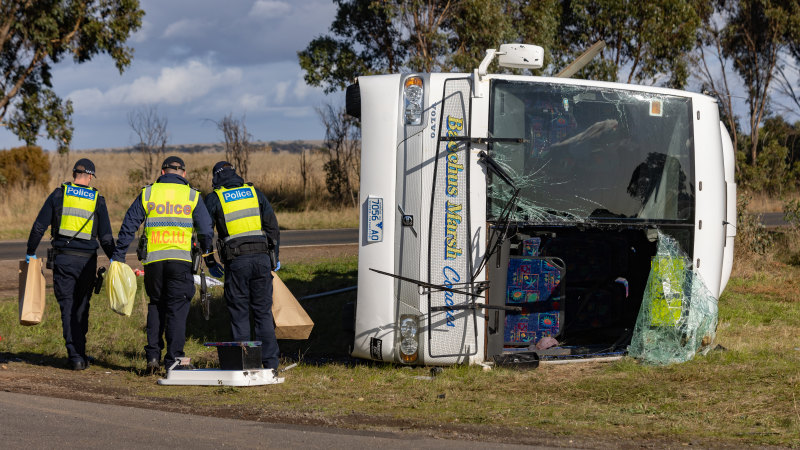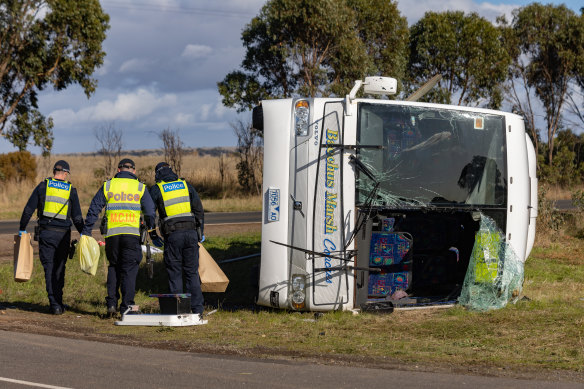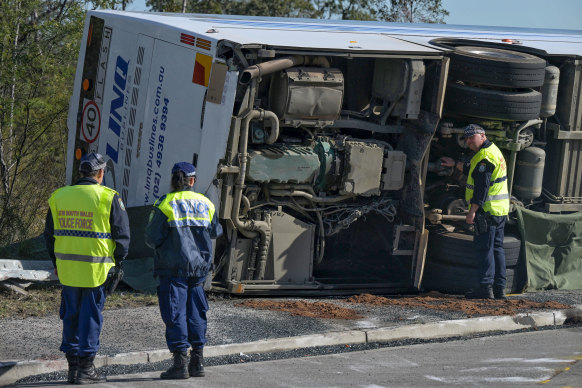Save articles for later
Add articles to your saved list and come back to them any time.
Victoria is facing calls to fast-track the replacement of more than 100 regional school buses that do not have seatbelts after two horror crashes that have thrown a spotlight on bus safety.
The state government is reviewing school bus seatbelt rules after 13 children were hospitalised – 10 with serious injuries – when an Exford Primary School bus crashed on Melbourne’s western outskirts last month.
Thirteen children were taken to hospital after the Exford Primary School bus crash last month. Credit: Jason South
Ten people were killed in the Hunter Valley in NSW on Sunday when a bus carrying 35 wedding guests rolled, in one of the country’s worst road disasters.
In Victoria, it is compulsory to wear a seatbelt on a bus or a coach if one is available, but there are no laws making it mandatory for them to be installed, including on school buses.
Parents Victoria chief executive Gail McHardy said her group had been pushing for more than a decade to make seatbelts mandatory on school buses – especially in regional areas where they travel on high-speed country roads – and wanted it finally implemented.
“It should not take recent events in Australia with fatalities, life-long injuries or near misses to make people in government or private enterprise make sure all buses are fitted with seatbelts,” she said. “We all belt up in our cars, so why not on the bus?”
Police at the scene of the deadly Hunter Valley bus crash.Credit: Nick Moir
Emergency responders to the Exford Primary bus crash said most of the 45 children on board were wearing seatbelts, which prevented more serious injuries.
A Department of Transport and Planning spokesperson said 1295 out of 1448 dedicated free regional school buses now had seatbelts installed, after the state committed in 2013 to ensuring they were fitted on all new school buses. The department could not provide figures for how many metropolitan school buses had seatbelts installed. All remaining 153 regional buses would be fitted with seatbelts by the end of 2024, the spokesperson said.
Chris Lowe, executive director of industry group BusVic, said the state should cover the cost of fast-tracking replacement of older regional school buses without seatbelts.
“They can bring on those replacements or they can fund a retrofitting campaign,” he said.
Lowe said Victoria’s bus seatbelt rules were appropriate and the only problem was making passengers buckle up.
“People take their seatbelts off because they want to move about the bus. Children … are told by their parents, their schools and the bus driver, but it just doesn’t happen,” he said.
“The driver can yell out and pull over … but at the end of the day the bus driver has to drive the bus – he can’t do two things at once.”
Public Transport Victoria advises that passengers must wear a seatbelt if they are installed on their bus, but it notes “bus drivers will continue to be exempt from monitoring or enforcing passengers to wear seatbelts”.
Monash University Accident Research Centre associate professor Stuart Newstead said all buses should be fitted with seatbelts and wearing them should be enforced. He said buses were a relatively safe mode of travel, but had the potential for disastrous outcomes if they crashed.
“Going down the Monash or Eastern Freeway, you see them [buses] frequently packed to the gills with people doing 100km/h, and if something were to happen at that speed – if it hit a truck or rolled over – that would be a catastrophic outcome,” he said.
Lowe said passenger capacity on city commuter buses would effectively halve if seatbelts were made compulsory and people were unable to stand. He said he believed all commercial charter buses in Victoria already had seatbelts installed, which made a mandate unnecessary.
Nationwide, 34 bus occupants died in crashes between 2012 and 2021 out of 11,916 deaths recorded across all road users, according to the Bureau of Infrastructure and Transport Research Economics.
A 2017 study by Monash University’s Victorian Injury Surveillance Unit found nine people died in bus crashes in the state between 2005 and 2014, with an average of 85 hospitalisations a year.
The Department of Transport and Planning spokesperson said bus drivers are told they have a duty of care to tell passengers they must wear a seatbelt. The department would report back after it had conducted its review of school bus rules.
“We will always consider measures that can improve safety on our roads,” the spokesperson said.
The Morning Edition newsletter is our guide to the day’s most important and interesting stories, analysis and insights. Sign up here.
Most Viewed in National
From our partners
Source: Read Full Article


